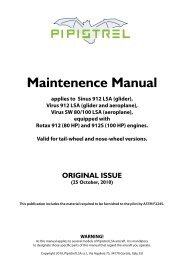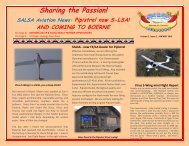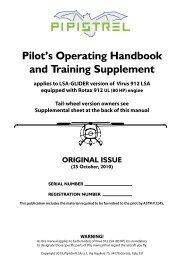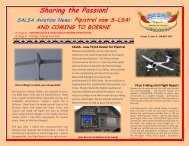Pipistrel Virus Aircraft Operating Instruction - Salsa Aviation
Pipistrel Virus Aircraft Operating Instruction - Salsa Aviation
Pipistrel Virus Aircraft Operating Instruction - Salsa Aviation
Create successful ePaper yourself
Turn your PDF publications into a flip-book with our unique Google optimized e-Paper software.
AIRCRAFT OPERATING INSTRUCTIONS – VIRUS 912 S-LSA GLIDERThis is flat wrong! The wing structure in light planes is usually certified to take +3.8 G’s, -1.52 G’s (plus acertain safety factor). Put more load on the wing than that and you can lose a wing. But here is the nicepart: below a certain speed, the wing simply cannot put out a full 3.8 G’s of lift! It will stall first! Thisspeed is called Maneuvering Speed or V A . Maneuvering Speed is defined as the maximum speed theplane can be flying at and still stall before the wing breaks no matter how much you pull back on thestick. If you are going slower than the V A and you pull the stick all the way back, the wing will stall withoutbraking physically. If you are going faster than the V A and you pull the stick all the way back, the wing canput out so much lift that it can be expected to break. Therefore people think they can deflect the stick asmuch as they desire below Maneuvering Speed and stay alive. Right? No, wrong! This is a trick question.The Maneuvering Speed is based on pulling back on the stick, not pushing it forward! Note what wassaid above: The V A is defined as how fast you can fly and not be able to put out more than 3.8 G’s of lift.But while the plane is certified for positive 3.8 G’s, it is only certified for a negative G-load of 1.52 G’s! Inother words, you can fail the wing in the negative direction by pushing forward on the stick well belowthe V A ! Few pilots know this.Also, for airliners, certification basis require that the rudder can be fully deflected below ManeuveringSpeed, but only if the plane is not in a sideslip of any kind! (e.g. crab method of approach) Does this makesense at all? Why would you need to fully deflect the rudder if not to re-establish wings-level flight?In a wonderfully-timed accident shortly after Sept. 11th, 2001; which many first thought an act ofterrorism, an Airbus pilot stomped the rudder in wake turbulence while the plane was in a considerablesideslip. The combined loads of the sideslip and the deflected rudder took the vertical stabilizer to itscritical load. A very simple numerical analysis based on the black box confirmed this. The airplane lost itsvertical stabilizer in flight and you know the rest. Also, if you are at your maximum allowable g-limit (e.g.3.8) and you deflect the ailerons even slightly, you are actually asking for more lift from one wing thanthe allowable limit! Therefore combined elevator and aileron deflections can break the plane, even if theelevator is positive only!SO, WHEN YOU THINK THAT YOU CAN DO AS YOU PLEASE WITH THE CONTROLS BELOW MANEUVERINGSPEED, YOU ARE WRONG!9. AIRCRAFT GROUND HANDLING AND SERVICING.9.1 Ground Handling.Engine start-upMake sure both fuel valves are open and master switch in OFF position (key full left).Should theengine be cold, apply choke (lever full back). Set master switch ON (key in full right position). Setboth magneto switches ON. Avionics OFF. Engage engine starter and keep it engaged until theengine starts. Set throttle to 2500 RPM. Slide the choke lever forward gradually.CAUTION! When the engine is very cold, the engine may refuse to start. Should this occur, movethe choke handle fully backwards and hold it there for some 20 seconds to make mixture richer.Engine warm-up procedureThe engine should be warmed-up at 2500 RPM up to the point working temperature is reached.Warming-up the engine you should:1 Point aircraft’s nose into the wind.2 Verify the enginetemperature ranges within operational limits.CAUTION! Avoid engine warm-up at idle throttle as this causes the spark plugs to turn dirty andthe engine to overheat.Page 38








